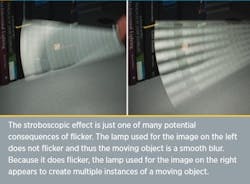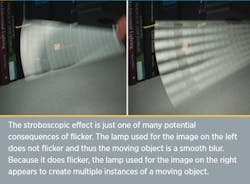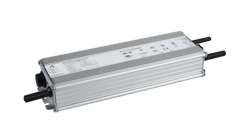Lighting flicker in LED-based products remains a concern, but the Institute of Electrical and Electronic Engineers has defined acceptable levels for the vast majority of people.
The Institute of Electrical and Electronic Engineers (IEEE) has published a recommended practice entitled "Recommended Practice for Modulating Current in High-Brightness LEDs for Mitigating Health Risks to Viewers" that defines acceptable limits to flicker in LED-based lighting systems. The document, IEEE Std 1789-2015, defines key metrics and offers solid-state lighting (SSL) product developers guidance on how to ensure that LED-based products present no danger to humans.
Source: “Solid State Lighting Technology Fact Sheet: Flicker,” US Department of Energy
Lighting flicker has long been known to cause maladies in humans that range from discomfort and headaches to seizures. As Jim Brodrick of the Department of Energy SSL program noted in one of his Postings emails, the advent of high-frequency electronic ballasts in fluorescent lighting eliminated flicker as a concern, but that LEDs with no persistence in producing light means that SSL reintroduced the flicker issue.
Clearly, LED-based products with well-designed drivers can deliver light with no detectable flicker. But eliminating flicker can increase the cost and/or size of electronic driver circuits. Indeed, Brodrick noted that smaller products such as MR16 replacement lamps are more susceptible to flicker due to size limitations on the driver. Moreover, LED-based lamps or luminaires designed to work with phase-cut dimmers such as triacs can exhibit flicker at dimmed settings even when exhibiting no problematic flicker at full output.
The just-published IEEE standard uses the metric percent flicker, frequency of a light source, and flicker index. The authors created a graph based on multiple studies of flicker that charts percent flicker (also called modulation) relative to the operating frequency of a light source switching on and off. The graph identifies a safe region and also a low-risk region for flicker.
The standard document ultimately provides an equation through which maximum percent flicker can be determined. You multiply the frequency of a light source by 0.08 and round up to calculate the maximum percentage. At 120 Hz, 10% maximum flicker is allowable. There are additional equations that can be used to determine maximum flicker at low operating frequencies.
The new standard is available for purchase. We've also published a number of driver-design centric articles on eliminating flicker. For example, Inventronics contributed an article on the topic last year. We also covered the early work by the IEEE group on lighting flicker.






